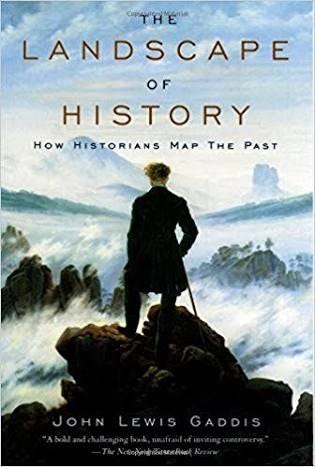Gaddis the Landscape of History Summary
Lovett Professor of Military and Naval History at Yale University and is best known for his work on the Cold War. John Lewis Gaddiss The Landscape of History.

John Lewis Gaddis 17 Books Available Chapters Indigo Ca
Written in the tradition of Marc Bloch and EH.

. Based on a series of lectures given by the author at Oxford University the book offers a welcome introduction to historical methodology and an overview of the state of the art. In them he presents his thoughts on how and why historians pursue their profession. Oxford University Press 2002 224 pp.
Then he states that he uses the panting to describe what historical consciousness is all about. The methodology employed by academic historians defies easy characterization. And they can zoom in and.
He presents many convincing observations about how the two fields of study are alike. John Lewis Gaddis The Landscape Of History Analysis. Gaddis book is a book on methods of seeing studying and relating history.
The Landscape of History. Carr The Landscape of History is at once an engaging introduction to the historical method for beginners a powerful reaffirmation of it for practitioners a startling challenge to social scientists and an effective skewering of post-modernist claims that we cant know anything at all about the past. How Historians Map the Past is a defense of the methodologies of historians in which Gaddis the famed Yale University Cold War historian argues that the methodologies of historians while differing from those of social scientists are very similar to those of natural scientists.
It is hard not to like Mr. The Landscape of History is a short work whose prevailing tone is that of an old scholar passing wisdom on to a young one. The Landscape of History.
Our book club of amateur historians had decided to read The Landscape of History by famous Cold War historian John Lewis Gaddis for this month. THE LANDSCAPE OF HISTORY A young man stands hatless in a black coat on a high rocky point. The Landscape of History is based on the series of lectures presented by John Lewis Gaddis during his Eastman Visiting Professorship at Oxford University.
In chapter 2 of his book The Landscape of History John Lewis Gaddis addresses the topic of time and space. In chapter 2 of The Landscape of History John Lewis Gaddis discusses time and space which he identifies as the field in which history happens 35. They can be in several times and places at once.
The Landscape of History. Oct 23 2017 7 min read. Gaddis argues that historians have the capacity for selectivity simultaneity and the shifting of scale.
In the book The Landscape of History John Lewis Gaddis compares the study of history to the study of natural science. Gaddis makes the case that the past may not be prologue but it can be explored for lessons to guide human action. Chapter 1 is titled The Landscape of History and introduces John Lewis Gaddis the author main argument.
In chapter 3 he discusses the mechanism of historical studystructure and process. In The Landscape of History he argues that both history and the social sciences are scientific but what the disciplines are concerned with differs. Gaddis for his good faith and honesty.
Paperback 1595 This lightweight book by Yale Universitys John Lewis Gaddis sets about creating a retrospective and pleasantly didactic handbook for examining the craft of historians. The Landscape of History. His back is turned toward us and he is bracing himself with a walking stick against the wind that blows his hair in tangles.
In simplistic terms social scientists are concerned with the future and historians. They can select from a cacophony of events what they think is really important. John Lewis Gaddis.
The author opens the book with a metaphorical. Historians interpret the past for the purposes of the present with a view to managing the future but to do so without suspending the capacity to assess the particular circumstances in which one might have to. By John Lewis Gaddis.
It will be essential reading. Employing a wide range of metaphors from Cleopatras nose to Napoleons underwear displaying an extensive knowledge of current thinking in mathematics physics. Here is the first chapter summary.
Gaddis focuses on the similarities and differences between historical processes and scientific ones. Rethinking Cold War History 1997 adapts the lectures he gave at Oxford while its George Eastman Visiting Professor 200001. In a word the book is about how.
Xii 192 pp. Landscapes Of History. Gaddis Military and Naval HistoryYale.
The Landscape of History. Gaddis is enthusiastic about the nature of history and its problems and his well intentioned disposition are everywhere visible in the book. The Landscape of History is a delightful integration of a number of topics ranging from complexity theory to agency tocounterfactuals and probabilistic thinking.
Causes are like tributaries leading to the present where they pause but for an instant and then recede into the distance from which point we try to map their course. He wants to relate to the reader the job of the historian- not just the act of knowing history- how one can see history as a landscape and how one can take in everything all at once. How Historians Map the past.
At the beginning of the chapter he describes the painting that is on the front of the book called The Wanderer above a Sea of Fog. Gaddis argues that the historians work of incorporating a multiplicity of causes rather than a single-cause explanation in order to explain an historical event is exactly like the job of evolutionary science or astrophysics. Ad Browse Discover Thousands of Book Titles for Less.
Gaddis is the Robert A. A masterful statement on the historical method by a distinguished Cold War historian. In this relatively short book Professor Gaddis has provided an insightful and interesting comparison between history and the sciences as well as much needed discussion on how to do history.
Before him lies a fog-shrouded landscape in which the fantastic shapes of more distant promontories are only partly visible. How Historians Map the Past. In The Landscape of History John Lewis Gaddis offers an insightful glimpse at what historians do.
Oxford University Press 2004. Gaddis updates our understanding of history by using complexity theory to help us appreciate how causes merge and meld into the unfolding of reality. Gaddis thrust is that the historical method whatever that is is more like modern science than social science.

A Short Review Of John Lewis Gaddis The Landscape Of History Hubpages

John Lewis Gaddis 17 Books Available Chapters Indigo Ca

Review Of The Landscape Of History How Historians Map The Past

The Recognitions By William Gaddis

John Lewis Gaddis Landscape Of History Youtube

On Grand Strategy Paperback Community Bookstore

Book Dissection And Comparison Docx 1 Book Dissection And Comparison Name Institution Professor Date 2 U2018the Landscape Of History U2019 By U2018lewis Course Hero

Review Of The Landscape Of History How Historians Map The Past

Analysis Of William Gaddis S Novels Literary Theory And Criticism

1484 Gaddis Rd Canton Ga 30115 Mls 7018135 Redfin
John Lewis Gaddis S The Landscape Of History Book Review Notes Analysis Poor Ash S Almanack By Askeladden Capital

The Landscape Of History By John Lewis Gaddis Some Brief Thoughts By Blessy Medium

Imaginative Horizons An Essay In Literary Philosophical Anthropology Crapanzano

The Landscape Of History By John Lewis Gaddis Audiobook Audible Com

John Lewis Gaddis S The Landscape Of History Book Review Notes Analysis Poor Ash S Almanack By Askeladden Capital

Cold War Statesmen Confront The Bomb Nuclear Diplomacy Since 1945 By John Lewis Gaddis
John Lewis Gaddis S The Landscape Of History Book Review Notes Analysis Poor Ash S Almanack By Askeladden Capital
Comments
Post a Comment